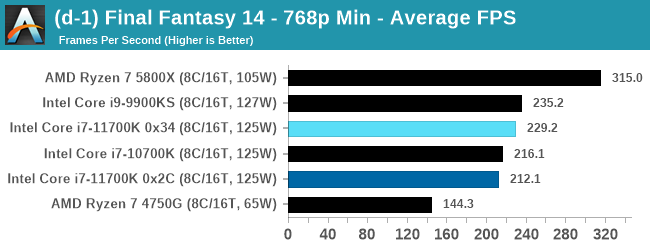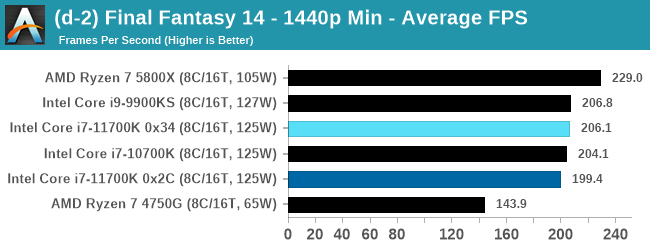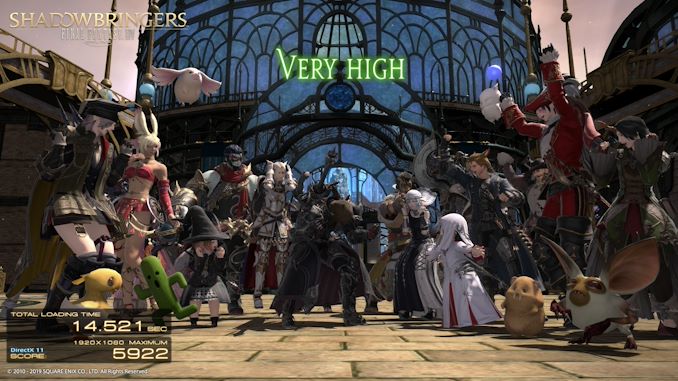Intel Core i7-11700K Review: Blasting Off with Rocket Lake
by Dr. Ian Cutress on March 5, 2021 4:30 PM EST- Posted in
- CPUs
- Intel
- 14nm
- Xe-LP
- Rocket Lake
- Cypress Cove
- i7-11700K
Gaming Tests: Final Fantasy XIV
Despite being one number less than Final Fantasy 15, because FF14 is a massively-multiplayer online title, there are always yearly update packages which give the opportunity for graphical updates too. In 2019, FFXIV launched its Shadowbringers expansion, and an official standalone benchmark was released at the same time for users to understand what level of performance they could expect. Much like the FF15 benchmark we’ve been using for a while, this test is a long 7-minute scene of simulated gameplay within the title. There are a number of interesting graphical features, and it certainly looks more like a 2019 title than a 2010 release, which is when FF14 first came out.
With this being a standalone benchmark, we do not have to worry about updates, and the idea for these sort of tests for end-users is to keep the code base consistent. For our testing suite, we are using the following settings:
- 768p Minimum, 1440p Minimum, 4K Minimum, 1080p Maximum
As with the other benchmarks, we do as many runs until 10 minutes per resolution/setting combination has passed, and then take averages. Realistically, because of the length of this test, this equates to two runs per setting.

| AnandTech | Low Resolution Low Quality |
Medium Resolution Low Quality |
High Resolution Low Quality |
Medium Resolution Max Quality |
| Average FPS |  |
 |
 |
 |
As the resolution increases, the 11900K seemed to get a better average frame rate, but with the quality increased, it falls back down again, coming behind the older Intel CPUs.
All of our benchmark results can also be found in our benchmark engine, Bench.











541 Comments
View All Comments
nandnandnand - Friday, March 5, 2021 - link
Alder Lake on 10nm will fix everything, and be out before the end of the year.kgardas - Friday, March 5, 2021 - link
The power consumption you comment shows while using AVX512 on hand optimized test. Your idea about Alder Lake to solve this is not the correct one as Alder Lake itself will not implement AVX512 ISA at all. IMHO very bad decision by Intel again.TheinsanegamerN - Friday, March 5, 2021 - link
Yeah, some weak ant sized atom cores are what intel needs to fix this problem LOLnandnandnand - Friday, March 5, 2021 - link
You don't need more than 8 big cores for gaming. With a real IPC improvement, 8+8 should be able to beat the 5900X.lmcd - Friday, March 5, 2021 - link
Not likely, but it'll at least beat the 5800X and probably go even on efficiency. The real upside is in the server space and laptop space. I expect Alder Lake to do excellently in both of those segments.nandnandnand - Friday, March 5, 2021 - link
Alder Lake's Golden Cove cores should have a decent IPC improvement over Rocket Lake, so 8 of those cores should be able to match more than 8 Zen 3 cores. Then throw in the 8 Gracemont Atom cores which will be better than Tremont. 8+8 should top 5900X but not 5950X in multi-threaded, and beat Zen 3 in gaming.There's caveats, perhaps related to DDR5 or schedulers, but I will be surprised if the top Alder Lake chip can't beat the 5900X.
DigitalFreak - Friday, March 5, 2021 - link
Sorry, but in this case 8 + 8 does not equal 16.nandnandnand - Friday, March 5, 2021 - link
5900X is 12 cores, not 16. That's what Alder Lake 8+8 has a chance of beating.SaturnusDK - Saturday, March 6, 2021 - link
The problem is that Alder Lake has been pushed to second half of 2021 at the earliest so it will not be competing against Zen3 but Zen4.Pneumothorax - Saturday, March 6, 2021 - link
It might be able to beat the 5900x, but by the time you add in Intel's overpriced motherboards (have you looked at Z590's recently?!) and the premium of DDR5, you're going to be at 5950x+ pricing.